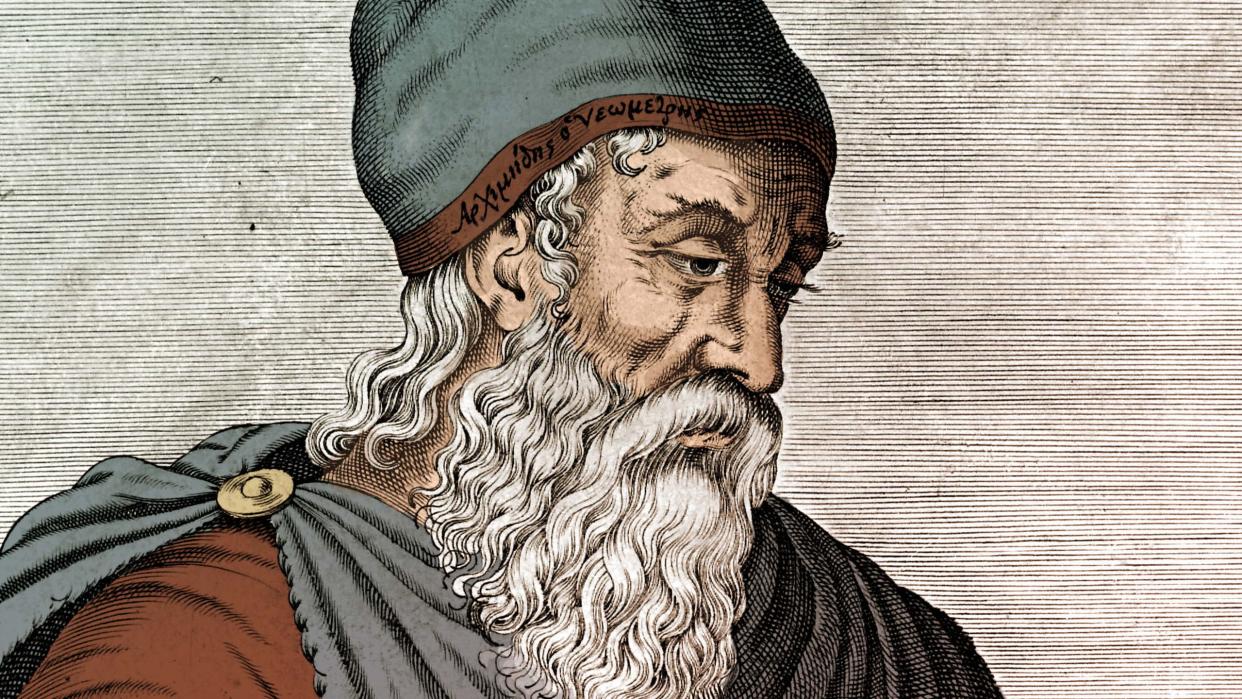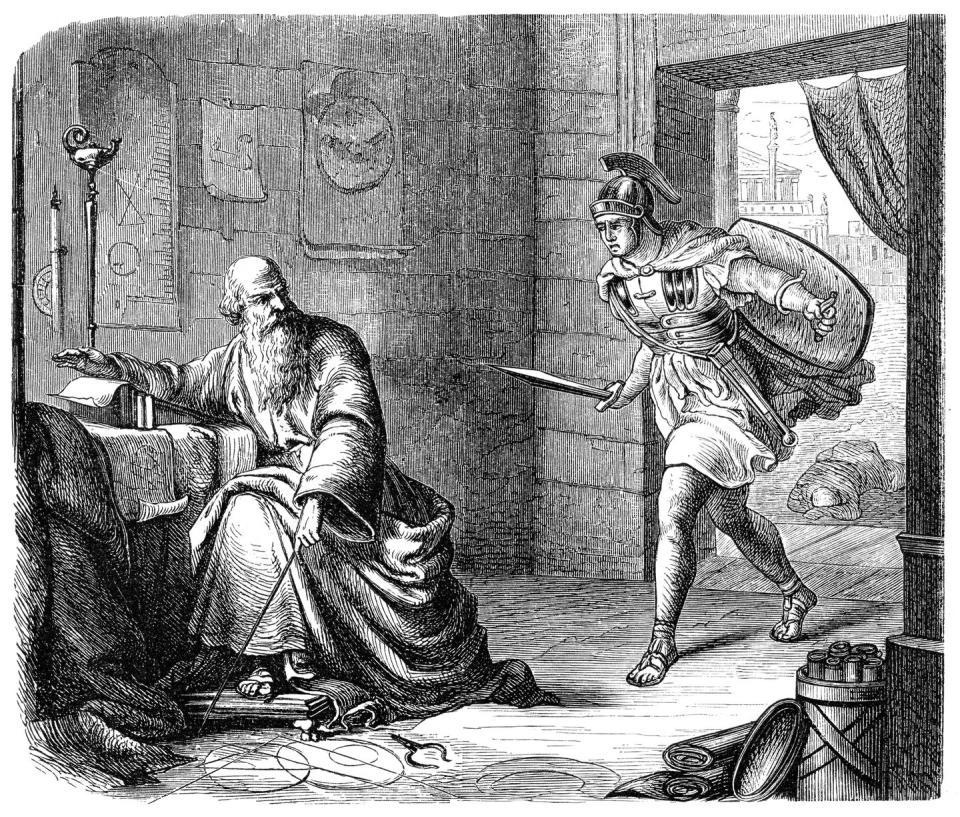Archimedes: The Mathematician Who Discovered Pi

- Oops!Something went wrong.Please try again later.
It’s the most wonderful time of the year—for mathematicians, anyway.
Pi Day is Thursday, March 14. The relatively new holiday is a celebration of the mathematical calculation pi, or the infinite number representing the constant ratio of a circle’s circumference to its diameter. Pi is essential to engineering and modern construction.
Although many sought to find it, the calculation of pi, which is also expressed by the fraction 22/7, is commonly credited to Greek mathematician Archimedes of Syracuse more than 2,200 years ago.
According to History.com, physicist Larry Shaw founded Pi Day day in 1988, selecting March 14 because the numeric date represents the first three digits of pi (3.14). It also happens to be Albert Einstein’s birthday.
The first Pi Day took place at the Exploratorium, a San Francisco–based science museum, and featured a circular parade and fruit pies. The latter has become a delicious tradition among academic and office settings. In 2009, the U.S. House of Representatives passed a resolution recognizing March 14 as National Pi Day.
According to the Exploratorium, mathematicians began using π, the Greek letter pi, for the calculation’s symbol in the 1700s, starting with William Jones in 1706. Leonhard Euler subsequently popularized the symbol.
As for Archimedes, you might be surprised to learn that pi was just one of his many important discoveries and inventions.
Who Was Archimedes?

According to NOVA, Archimedes was born in Syracuse—on the Mediterranean island of Sicily, not upstate New York—around 287 BCE. He was the son of astronomer Phidias and a close ally of Syracuse’s King Hieron and his son, whom he served many years.
Archimedes traveled to Egypt to study at the Library of Alexandria at age 18 and, upon completing his work, returned to Syracuse around 263 BCE for the remainder of his life.
Over roughly the next 50 years, Archimedes developed most of his major theories. These included the fundamental principles of mechanics; methods for finding the center of gravity, surface area, and volume of geometric figures; the principle of buoyancy; and, of course, an estimate for the value of pi.
Archimedes was obsessed with math, often getting lost in his work and forgetting to eat. Legend has it he discovered his principle of buoyancy while taking a bath. Excited, he leapt out of the tub and ran naked through the streets of Syracuse shouting, “Eureka!”
By one account, Greek philosopher Plutarch reported that Archimedes died while solving a math problem. In 212 BCE, during the Second Punic War, a Roman solider asked Archimedes to accompany him amid a siege of Syracuse. Archimedes refused, and the angry soldier stabbed him with a sword.
What Else Did Archimedes Do?
Archimedes is often credited with inventing the Archimedes’ screw, a device for raising water, while in Egypt. The large helix is encased lengthwise in a watertight covering with openings at both ends. When one end is placed in water and the device is elevated at an angle and turned, water trapped in air pockets rises from the lower end through the open upper end.
Back then, it was used to pump water out of ships and for irrigation. But the design is still used today. According to Scientific American, modern examples include lifting wastewater in treatment plants and even lifting water for some amusement park rides.
Archimedes also created a means for approximating square roots and devised ways of calculating area and volume two millennia before the invention of calculus.
When the Romans invaded Syracuse, Archimedes’ “engines of war” helped defend the city. These devices included cranes to drop rocks, claws to lift ships from the water, and machines to fire wooden missiles. He also devised a set of mirrors that focused sunlight on enemy ships, setting them on fire.
Finally, Archimedes proved the volume of a sphere is two-thirds the volume of a circumscribed cylinder. He considered this his greatest accomplishment and asked that a representation of a sphere inside a cylinder be left on his tomb. He is likely buried in Sicily.
Tracing Archimedes’ Legacy
According to NOVA, scribes copied Archimedes’ writings onto parchment in 300 AD. His manuscript explaining how he developed his mathematical theorems was copied and bound onto vellum sheets around 1000. Archimedes’ treatise Measurement of a Circle—which helped spread his process for calculating pi around the world, according to the American Mathematical Society—was part of this manuscript.
Around 200 years later, a monk reused the manuscript to make a prayer book. Finished in 1229 and likely made in Jerusalem, this manuscript became known as the Archimedes Palimpsest. It is the only surviving copy of Archimedes’ manuscript and contains several of his treatises.
For about 400 years, the Palimpsest was stored in a monastery in the Judean desert before being moved to a library in Old Jerusalem. German scholar Constantine Tischendorf discovered it in Constantinople in 1846, and Danish scholar Johan Ludwig attempted to transcribe it in 1906 using a magnifying glass.
Shockingly, the Palimpsest disappeared for much of the 20th century. It resurfaced in a damaged state in Paris in 1998 and was sold at auction for $2 million to an anonymous American collector. The buyer then donated the book to the Walters Art Museum in Baltimore in 1999. It was featured there in a 2011 exhibit titled “Lost & Found: The Secrets of Archimedes.”
You Might Also Like

